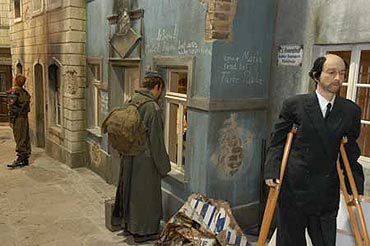Schrift: größer/kleiner
Inhaltsverzeichnis
Sie sind hier: WirRheinländer > english version > The Exhibition > Scenes > 1945
broken Nazi eagle, ruins

On 8th May 1945 the German Army capitulated. Almost the entire area of the 3rd Reich was occupied by Allied troops. National Socialist rule was at an end. The Nazi State no longer existed. Germany disappeared from maps in its hitherto existing form. What remained was a bombed, occupied, but liberated country without the legitimacy of a state.
The cities lay in the ruins of rubble and ashes. Homes, transport infrastructure and supply systems had been destroyed. The struggle for survival was at the forefront. This was aggra-vated by millions of refugees who flowed into their new homeland in the west from the east-ern territories.
The Parish Chronicle of Dahlem in the Eifel reported on the end of the war:
"When the war ended, the village was a sorry sight. 10 % of the village was completely destroyed, most of the remaining houses were damaged. As a makeshift solution, the roofs were covered with planks, or patched up with metal from petrol cans which had been split open. As the electricity supply had been interrupted, in the evenings people squatted together under the feeble light of carbide lamps. No trains could travel on the destroyed railway lines. Freedom of movement on the roads was restricted by the oc-cupying forces, but then loosened up gradually. … there was a shortage of petrol for cars. … lorries which had survived the war, or which were assembled from various wrecks, drove with wood carburettors and "filled up" with dry wood instead of petrol."
(Arntz, Hans Dieter: Kriegsende 1944/1945 im Altkreis Schleiden, Euskirchen 1995, S.298.)


